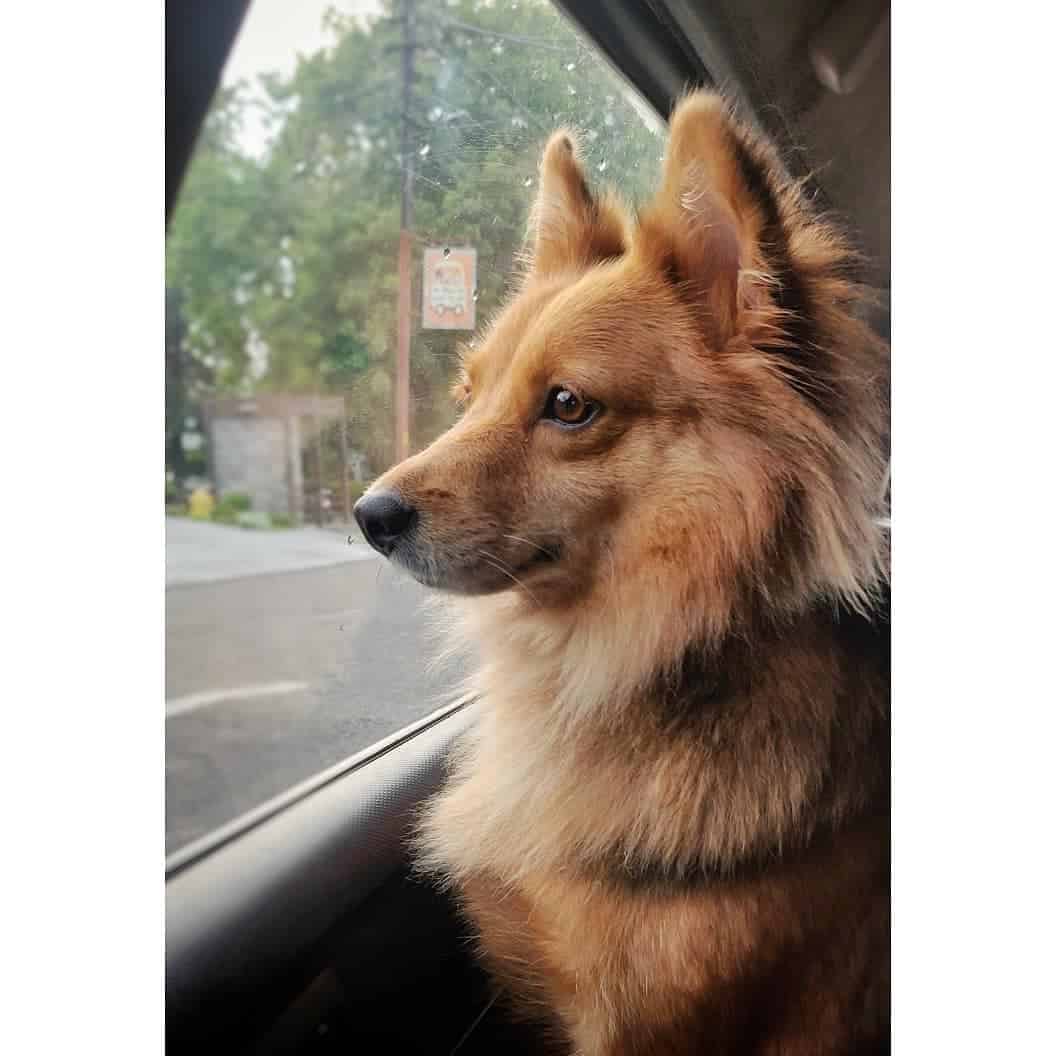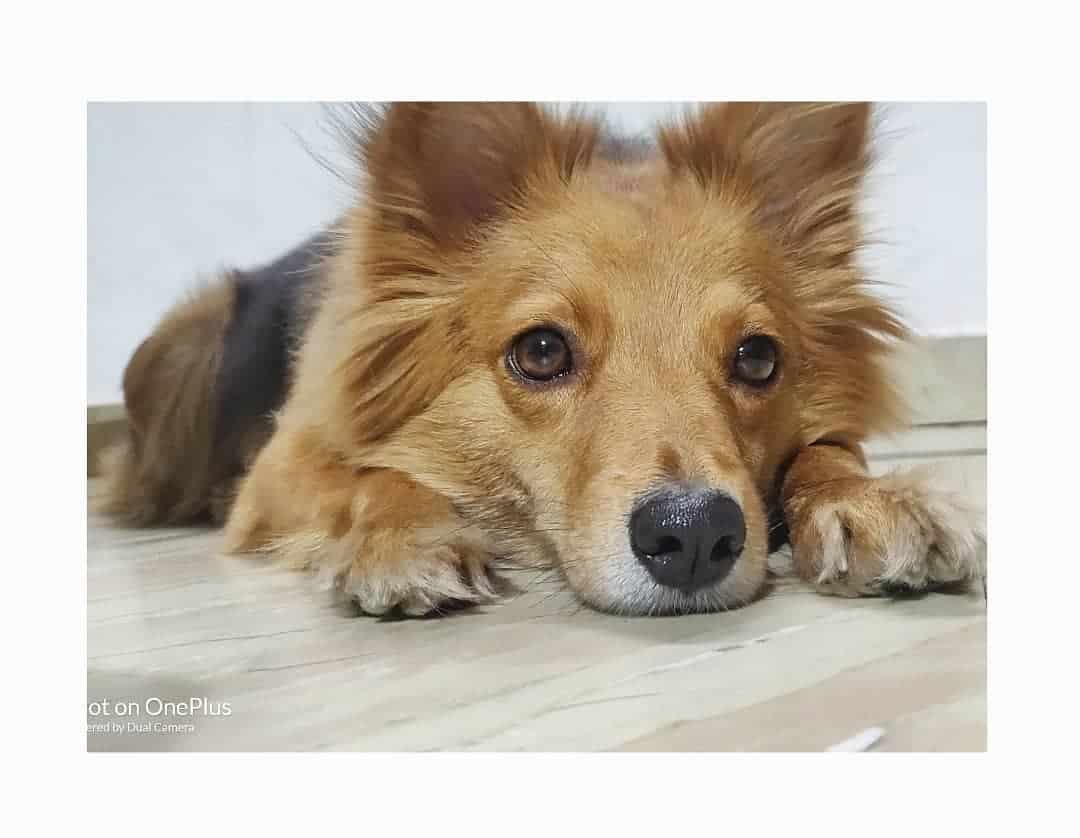German Shepherds and Pomeranians are polar opposites as dog breeds, so it’s no wonder that you might not have known that they can actually crossbreed. The result of that breeding is the adorable German Shepherd Pomeranian mix.
The physical differences between the two parent breeds make a lot of people skeptical about German Poms. Usually, when you think of mixed breeds, you think of crossing two relatively similar breeds, like a Cocker Spaniel and a Poodle, or a German Shepherd and a Siberian Husky.
However, breeders have found a way to overcome these differences and create a very unique dog.
In this article, we will go in-depth about the German Shepherd Pomeranian mix, telling you everything you need to know about its origin, physical and mental attributes, its habits concerning feeding and exercise, as well as any potential health problems.
If you are a German Pom owner, looking to become one in the future, or even if you’re just generally curious about this mixed breed — this article will be a great read for you.
What Is The German Shepherd Pomeranian Mix?

Photo from: @lucy.the.germaranian
The German Shepherd Pomeranian mix, as its name suggests, is a crossbreed between a purebred German Shepherd and a purebred Pomeranian.
Despite the noticeable differences in their appearance and size, these two parent breeds actually have a lot more in common than you might have thought.
German Shepherds and Pomeranians both originated from Germany, and that is still the region of the world in which they are most popular and common.
They are both considered to be among the best working dogs in the world, and they both make great family pets. Their unwavering loyalty, protectiveness, and ability to develop strong relationships with their owner make them perfect family companions.
According to the American Kennel Club, GSDs are the fourth-most popular breed of all, behind only Labrador Retrievers, French Bulldogs, and Golden Retrievers. Their popularity alone makes them a common choice for creating mixed breeds.
From that perspective, crossbreeding them makes a lot of sense. This is exactly what breeders were thinking when they came up with this mixed breed, and the result was a dog that had all the working habits of a GSD and the more manageable size of a Pom.
How Do You Breed A German Shepherd With A Pomeranian?
We’ve already mentioned the size difference a few times, and it’s not exactly an issue that can be glossed over.
In fact, because of the huge discrepancy (sometimes up to 80 pounds!), breeders have understood that the only way for the process to be successful is for the Pomeranian parent to always be male.
Even though it might seem awkward, a Pomeranian male can mate with a German Shepherd female, but the opposite is not true.
GSD males are simply too large for a Pom female, and attempting to breed them that way could result in severe injury to the female, and it could even end up with her dying.
Furthermore, there are differences in the females’ ability to carry the litter. Even though Pomeranians have many different crossbreeds of their own, German Shepherd Pomeranian-mixed puppies can be too heavy for a Pom female to carry.
Hence, all breeders tend to stick with the formula of having a German Shepherd daddy and a Pomeranian mommy for their puppies.
German Shepherd Pomeranian Mix Appearance

Photo from: @lucy.the.germaranian
The physical appearance of German Pomeranian dogs largely depends on the traits that get passed down from each parent. For example, they can inherit a smoother and less fluffy coat from their GSD parent, and the red or orange color from their Pomeranian parent.
Some of the general traits that are common to all German Poms are the big eyes, medium-sized ears, long curly tail, and sort of a triangle-shaped face with a tapered snout.
Their frame is usually compact and proportional, which gives them a lot of surprising athletic advantages. They are fairly strong and quick for their size.
Now, let’s go through some of the physical characteristics that are much more difficult to pin down, like their exact size and coat color.
How Big Will A German Shepherd Pomeranian Mix Get?
German Shepherd dogs are classed as a large breed, and Pomeranians are considered as toy dogs. The difference between a male Pom and a female German Shepherd can sometimes be up to 18 inches (45.7 cm) in height, and 60 pounds (27.2 kg) in weight.
As you can imagine, this leads to a fairly wide range of possible sizes for their mixed-breed offspring. Typically, GSD Pom mixes will end up being medium-sized dogs, averaging about 14 inches (35.6 cm) in height, and 35 pounds (15.9 kg) in weight.
However, it’s not always as exact as calculating the average height and weight. For that reason, let’s get a better look into the size ranges of both of the parent breeds so that we can fully understand the size of the mix.
We have other, more extensive articles about the German Shepherd size and the Pomeranian size, but for the purposes of this article, we’ve created these handy charts.
German Shepherd Size Chart
[table id=585 /]
Pomeranian Size Chart
[table id=586 /]
German Shepherd Pomeranian Mix Size Chart
[table id=587 /]
Coat
Both of its parent breeds are double-coated, so German Pomeranian mixes will also have an undercoat and an outer coat.
When it comes to predicting what the length or the color of the hair will be, it’s nearly impossible. It entirely depends on which genes will come through more; therefore, it can be any combination of the parents’ colors, patterns, and fluffiness.
However, there are some colors that are slightly more common than others. Let’s take a look at all the variations of the parent breeds, and then of the mixed breed itself.
German Shepherd Coat Colors
When you think of the German Shepherd breed, you probably imagine them in that trademark black and tan combination. While that combo is iconic, there are other coat variants of GSDs. The standard ones are:
– Black and tan
– Black and red
– Black and silver
– Solid black
– Solid red
– Black with tan points
– Sable
Additionally, there are a few non-standard colors that are considered faulty or unapproved. These include blue, liver, and white.
Pomeranian Coat Colors
Pomeranians are much more varied in their coat color combinations than German Shepherds, and unlike them, the differences are much less subtle.
Here is a list of some of the officially accepted Pomeranian colors:
– Brown
– Chocolate
– Cream
– Black
– Orange
– Lavender
– Blue
– Sable
– Brindle
– Tan
– White
– Merle
If you think this is a long list, you’re right. But, what’s even more interesting is that Poms can have any sort of combo and mixture of these colors, including unique merle and multi-color patterns and spots.
This affects their offspring, too, so the German Pomeranian mix can come in a lot of different shades.
German Pomeranian Mix Coat Colors
There are a few colors that are found in both German Shepherds and Pomeranians; for example, if you breed a black GSD with a black Pom, chances are that most of the litter will be black as well.
But, of course, that isn’t always the case since puppies’ coat colors are influenced by their entire gene pool, including their grandparents, great-grandparents, etc.
And, with such a wide assortment of colors to choose from on both sides, you can see why breeders can’t really predict what colors they are going to get in each litter. If they are trying to get a specific hue, they will most likely pick parents that have it, and simply hope for the best.
Or, if they have access to the data about the grandparents, they can use that to slightly increase their odds, but even then, it involves a lot of guesswork and good old-fashioned luck.
With that in mind, let’s list some of the most frequent German Shepherd Pomeranian mix coat colors:
– Brown
– Cream
– Orange
– Red
– Black and tan
– Fawn
– White
– Black and white
– Sable
– Brindle
– Blue
German Shepherd Pomeranian Mix Personality

Photo from: @whiskersandtails_cindy
We’ve mentioned previously that both German Shepherds and Pomeranians are very high up on the list of most popular family dogs in the United States, and in the world in general.
There are many good reasons for that, but some of the main ones are their supreme intelligence and generally laid-back and friendly demeanor.
And, in the case of the German Shepherd Pomeranian mix, the apple doesn’t fall far from the tree. More times than not, they inherit most of these traits, which makes them quintessential family pets.
They are very bright and obedient, but also friendly and easy-going. This combination is perfect for families with kids as German Poms will get along with them easily.
Training
The German Pomeranians’ intelligence and proclivity to please their owner as much as they can make them very easy to train.
Drawing from the German Shepherd side of their family, they are able to quickly pick up instructions and learn new things, so even if you’re not an experienced dog trainer, this breed shouldn’t be a problem for you.
In fact, they might actually be the perfect breed for you to experience dog training for the first time. Whether you want to teach them tricks, train them as guard dogs, or have them do actual jobs such as shepherding, they will be eager to adopt those skills.
Be sure to start early in their puppyhood for the best results.
Activity Levels
If you want to know what the activity levels of a particular dog breed are, your best bet is to look at their history and ancestry, and pay attention to what they were bred for.
Even though they are now part of the Toy group, Pomeranians were originally much bigger in size. In fact, they descended from the Spitz breed, which is noticeably larger. Also, they were historically bred as working dogs, and they have kept some of those genes and habits to this day.
German Shepherds are probably the most famous working dog, and they are often considered to be the epitome of the herding dog. Even today, they are still used in a similar capacity in many places in the world.
All of this is to say that both of the German Pomeranian’s parent breeds are very active dogs that need to expend a lot of energy during the day. The same is true for their offspring.
German Poms can be labeled as high-maintenance in this regard as they need frequent stimulation and exercise. Even during their early puppyhood, it is recommended that you take them on daily walks and play with them as often as you can.
As they grow up, you should consider having them take part in physical activities such as herding, tracking, or agility exercises. This will satisfy their activity needs and stop them from becoming frustrated and developing unwanted behaviors.
Grooming Needs
This is another side of the German Pom that prospective owners have to take into account before getting a puppy. Depending on which parent it takes after more, the German Pomeranian can have pretty extensive grooming needs.
If the German Shepherd genes are more prevalent, then the dog’s coat will be significantly shorter and straighter. German Shepherds tend to shed a lot, which requires a decent amount of grooming, but that’s nothing compared to Pomeranians.
Pomeranians, of course, are notorious for the amount of care that needs to be put into maintaining their coat — beauty has a cost, after all — and the same goes for GSD Pom mixes that take after their Pom dads.
Their long hair will need daily brushing; otherwise, you risk it becoming an unkempt, tangled mess.
Aside from taking care of their coat, there are some other facets of grooming that you need to make a habit of.
You will need to regularly clean their ears in order to avoid infections, brush their teeth as often as you can, and wash their face, particularly the area around their eyes. Their Pom parents are susceptible to various eye issues, so it’s important that you keep them clean.
Are GSD/Pom Mixes Good Family Dogs?
You can probably deduce from everything we’ve said so far that German Pomeranians are excellent family dogs, but it doesn’t hurt to highlight this one more time.
They are very affectionate, fun-loving, and loyal by nature, and they will quickly grow attached to their owner. Generally speaking, they don’t pick favorites, but rather get equally close to each member of the family.
That’s what makes them so great! They are equally comfortable being a companion for an adult human, or a more protective pet for children. Their playfulness and gentle demeanor are perfect for kids growing up as they will provide unconditional love and companionship.
They’re basically the best of both worlds in regard to what personality traits they’ve inherited from their parent breeds. Pomeranians, for example, have a high-energy temperament that goes well with active kids who want to play a lot, but their diminutive size means that you have to be careful around them so as not to hurt them by accident.
The German Pomeranian mix, however, is significantly bigger physically, but it retains the same temperament, which allows for more freedom during playtime.
Are German Pomeranians Good Around Other Pets?
One of the first things you should consider before getting a new dog is how they will get along with your existing ones.
When getting a new dog, the rule of thumb is that dogs with a high drive will probably not fit well with other pets, such as cats or birds. For instance, any dog breed that has historically been bred for hunting will probably have the urge to start chasing them around.
But, since neither German Shepherds nor Pomeranians are hunting dogs, they normally don’t have that high drive, which is also true for the mix of these two breeds.
This means that they can safely coexist in a household with other dogs, and probably even cats, hamsters, etc. If you get them while they’re young and accustom them to socialization with other animals, they will learn to behave around them and not cause any issue.
What Does The German Shepherd Pomeranian Mix Eat?
German Pomeranians are not classified as a large breed, but they are incredibly active, which means that they need a high caloric intake in order to make up for all the energy that they expend during the day.
Your best choice is probably to focus on high-quality dog food that is specially formulated and designed for active dog breeds. It needs to be rich in proteins, healthy fats, vitamins, and minerals.
German Pomeranian Health Issues

Photo from: @lucy.the.germaranian
Both of their parent breeds are known for being healthy and long-lived, and thankfully, that is something that the German Pomeranians exhibit as well.
They are generally considered to be a very sturdy, healthy breed, but there are some health concerns that they can encounter during their lifetime. Let’s go through some of the most frequent ones.
Cancer
Cancer is one of the more prominent diseases that can affect all dog breeds. Even more than with humans, symptoms are usually hard to spot until it’s already too late, so it’s important to have regular check-ups with the vet.
Catching it early significantly increases the odds of beating it.
Degenerative myelopathy
This is a disease that is usually associated with German Shepherds, but their mixed breeds can sometimes develop it, too. Once dogs get closer to old age, their nervous system slowly starts degrading, and they become weaker and weaker.
In some cases, degenerative myelopathy can lead to partial or complete paralysis, particularly of the dog’s hind end.
Dental diseases
In the grooming section of the article, we briefly mentioned that you should brush your German Pom’s teeth as often as you can. There’s a good reason for that.
Generally, dogs aren’t exactly known for having great dental hygiene, so if you don’t put in extra effort to clean their teeth and gums, it can lead to dental diseases that can make it hard for them to eat, or cause them general pain in the jaw area.
Disc disease
Usually a problem for Pomeranians, disc disease can also affect their various crossbreeds.
It is a condition that causes the spinal discs to degrade, which, in turn, causes a great deal of pain in the nerves and in the spine. Depending on the severity of the degradation, you might have to resort to surgery.
It most often afflicts smaller breeds, like Chihuahuas and Dachshunds, but that doesn’t necessarily mean that it can’t befall your GSD/Pom mix, even if it happens to be larger than average.
Joint dysplasia
Joint problems are fairly common among large dogs due to their weight putting significant pressure on their skeleton.
German Shepherds often battle this condition, so if your mixed breed is leaning more towards its GSD part of the gene pool, it can be affected by this.
Hip dysplasia and elbow dysplasia are the most common variants, which means that the joint does not fit with the socket properly.
Patellar luxation
Patellar luxation is the occurrence of the kneecap (a.k.a. the patella) popping out of place. It can either happen every once in a while or be a regular thing, in which case it will severely limit your dog’s ability to move.
It mostly affects older dogs whose bones and joints aren’t as strong anymore.
Skin allergies
German Shepherd Pomeranians have a very complex coat, and if you’re not grooming it properly, it can fall victim to all sorts of issues, such as sores and dryness.
Since their coat is far from being hypoallergenic, it can be a ground for allergies to express their symptoms. GSDs in particular are very prone to being allergic to certain foods and byproducts, so be careful when choosing what to feed them.
In addition to all these conditions that we have listed, German Pomeranians can also be prone to issues like hypothyroidism, collapsed trachea, diabetes, cataracts, and congestive heart failure.
How Long Do Pomeranian German Shepherd Mixes Live?
Generally a very healthy dog breed with high energy levels, German Pomeranians are blessed with longevity. Their average life expectancy is between 10 and 15 years.
This is in line with the long lifespan of their parent breeds. German Shepherds are expected to live between nine and 13 years on average, while Pomeranians can often live to be 16 years of age.
Is the German Pomeranian Accepted By The American Kennel Club?
Since German Pomeranians are hybrid dogs, they are not a part of the official American Kennel Club registry.
However, both of the German Pom’s parent breeds (German Shepherds and Pomeranians) are purebred, and therefore, are accepted by the AKC.
How Much Is A German Pomeranian?

Photo from: Photo from: @lucy.the.germaranian
If you are looking to buy a German Shepherd Pomeranian mix puppy, it’s going to set you back around $1,000 to $3,000 when buying from a reputable breeder.
Even in the realm of designer dogs, these puppies are relatively expensive. For comparison, the price of purebred German Shepherds is basically half of that.
But, there are many possible reasons for that.
For example, we’ve already talked about how unpredictable the puppy color is in these litters, so if you’re dead set on a certain color, it might take a long time and a few attempts until the breeders finally get it right. This will, of course, significantly increase breeding costs.
Additionally, since German Pomeranians have a great reputation regarding their health, behavior, lifespan, and family life, breeders feel confident to charge extra because they know that there aren’t as many risks as with some other mixed-breed dogs, such as Pitbulls or Pomskies, for example.
The Conclusion
The German Shepherd Pomeranian mix is a truly unique breed, even by designer breed standards. The unlikely pairing of a proud, large watchdog such as the German Shepherd, and an energetic little furball like the Pomeranian is a genuine novelty for a lot of dog lovers.
Perhaps that’s why they remain a bit mysterious to some people who aren’t exactly sure what to think of them. That’s one of the reasons why we wanted to create an extensive guide to the German Shepherd Pomeranian mix, and bring these adorable, intelligent dogs closer to people.
If you already own a German Pom, then you can attest to how lovely they are, and if you were just looking to learn a bit more about them before adopting one, we’re sure this article has brought them out in the best light.
Read Next:
• Golden Retriever Pomeranian Mix: Double Cuteness Attack
• It’s A Yorkie Pomeranian Mix – What To Expect?
• German Shepherd Poodle Mix — Is Shepadoodle The Best Doodle?
